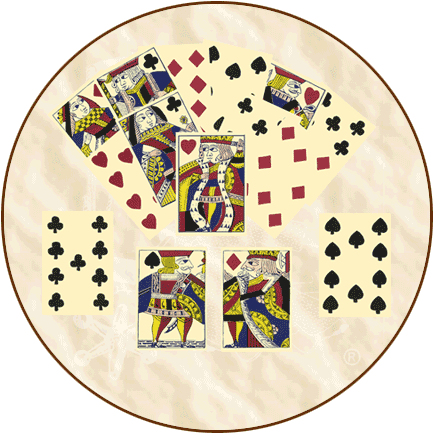.
Continued from product description on
Traditional Games' Page Three...
Historical
Background: Playing cards were invented during the 12th
century in China. These early cards were probably paper dominoes
since the official Chinese record for the invention of paper
was 105 A.D. Sir William Henry Wilkinson, a British sinologist,
published an article entitled "Chinese Origin of European
Playing Cards" in the American Anthropologist in 1895. This
historic paper compares Chinese and European decks of playing
cards and includes a wealth of information. From China, playing
cards may have spread to Venice, Italy, via Marco Polo or his
father.
From Venice, cards made their way to other European countries.
There are many mentions of cards from Ulm, Germany, in the late
1300s and early 1400s. Even though no actual card packs exist
from this time, it is certain that woodcuts would have been used
in their production by this time. The invention of the removeable-type
printing press made mass production of playing cards possible
around 1440.
Playing cards also became very popular for gambling. Preachers
denounced card playing and the conduct that followed "poor
losers" who exhibited bad behavior and emotional outbursts.
It was declared immoral and prohibitions sprang up in many cities.
Ulm, Germany, had a prohibition against card playing in 1397.
Other prohibitions and ordinances against card playing occurred
in Paris, France, in 1377; St. Gallen, Switzerland, in 1379;
Lille, France, in 1382; Barcelona, Spain, in 1382; and, again,
in Paris, France, in 1397 forbidding working people to play cards
on working days.
Some card decks from China featured only three "suits."
The four suits used in present-day playing cards (spades, hearts,
diamonds & clubs) are derived from the Middle Ages where
the Tarot deck reflected the societies of Medieval times. The
king ruled a world in which there were four classes: the church,
military, merchants, and farmers. These four classes were featured
as suits on the cards in the forms of cups (the church), swords
(military), pentacles or five-pointed stars (merchants), and
batons (farmers). When card popularity spread throughout Europe
and, particularly, into Germany during the 15th century, the
cups became hearts, the swords became spades, the pentacles became
diamonds, and the batons became clubs.
English playing cards from the 15th century probably evolved
from France. The first documentation of cards in England is from
an Act of Parliament (3 Edw. IV.c.4) in which domestic card makers
petitioned against the importing of foreign cards. At this point,
cards had plain backs, square corners, no numbers in the corners,
and the face cards were single ended.
It is thought that Christopher Columbus' expedition brought
playing cards to what is now Latin America. Cards were later
brought to the New World by Jamestown settlers. In the American
colonies, Puritan children were not allowed to play cards and
the sale of cards was prohibited in their communities. In the
Puritan Colony Laws of 1656, children and servants were to be
"publickly whipt" for second offenses of playing cards.
The county records of Plymouth, Massachusetts, show that in 1633
two heathens were fined two pounds each for card playing. The
colonists did, however, enjoy playing cards. When Captain James
Cook returned from England to Jamestown, Virginia, he found the
colonists starving, but still playing with cards!
Card designs featuring the King, Queen, Jack, and the "pip"
cards (cards without numbers from two to ten) did not change
much from the 15th to 19th centuries. During the mid-19th century,
face cards became double-headed and the card values appeared
in the left corners to allow greater ease in reading fanned cards.
Players would also not want their opponents to know whether they
had a face card by turning these cards right side up. Doubled-headed
face cards helped players "protect the hands" or not
"tip their hand" to another player.
Up until 1850, most playing cards had plain backs. Because
this plain side could become soiled or "marked" and
used for cheating, design patterns began to appear on the backs
of cards. In some American cities further inland, this type of
card deck with plain backs was used longer than 1850 simply because
it took a while for the other cards to migrate to western states
and territories. After cards were played with a number of times,
the square corners rubbed off and, so, rounded corners became
the new standard. After all, cards were made from only heavy
paper then and did not have the plastic-coated finish we see
on today's cards.
Native Americans also made their own cards, but not out of
paper. They used animal hides and decorated each card individually.
A set of North American Indian cards is displayed in the National
Museum in Washington, D.C.
Fun
Fact: The joker was invented because of a game called
Eucher, which needed one more high card. Card manufacturers would
add a blank card called the "Eucher card" in each deck.
The word was mispronounced and the "joker" was born!













